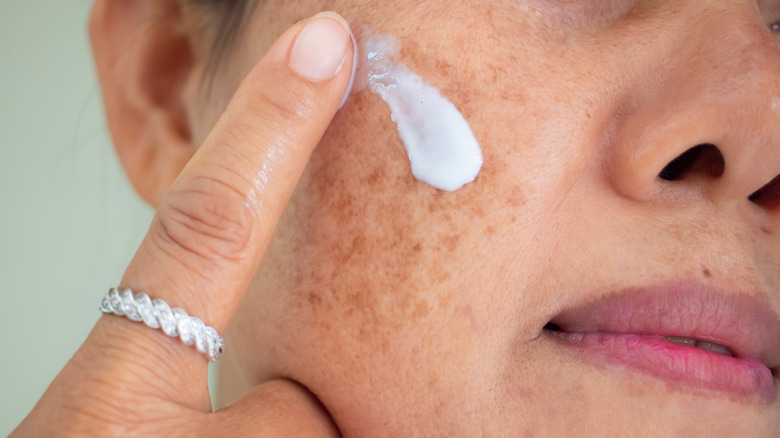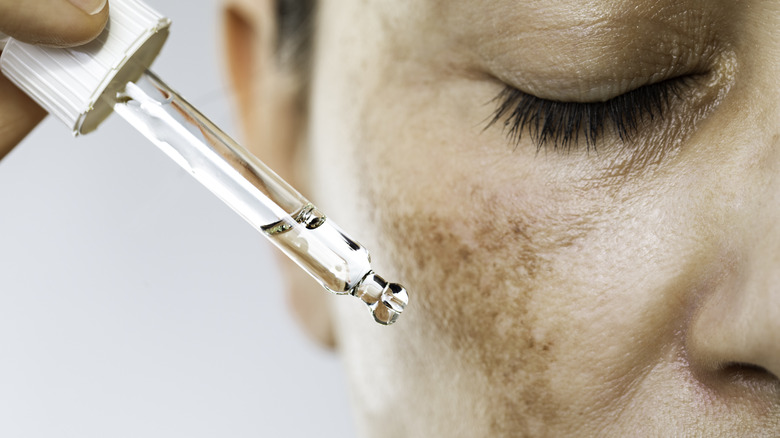Why You'll Want To Add Tranexamic Acid To Your Skincare Routine If You're Battling Dark Spots
Just when you thought skincare had come up with all the acids that could possibly exist, a new one pops up ready to takeover all routines. The latest ingredient to gain popularity in the beauty world is topical tranexamic acid, and despite being a mouthful to say, it's worthy of further investigation.
Interestingly enough, tranexamic acid is actually on the World Health Organization's List of Essential Medicines but not for anything to do with skincare. It turns out that the acid's primary medical function is stopping excessive blood loss, which is why it's normally prescribed to people who deal with excess bleeding from menstrual cycle. The skincare benefits of tranexamic acid were discovered quite by accident which, luckily for us, means we all get to benefit from a happy little accident.
As a skincare ingredient, tranexamic acid is said to not only help with brightening your skin tone, but also assist with diminishing dark spots and discoloration. Today, it can be found in both serums and other skincare treatments. Let's explore tranexamic acid and see if it might be worth adding to your skincare routine.
Tranexamic acid can do wonders for discoloration
Some people might not realize this, but getting rid of active pimples and inflammation is oftentimes only half the battle with acne-prone skin. Scarring, discoloration, and generally imperfect complexions are often left behind in acne's wake. Finding a way to combat the leftover evidence of acne while not disrupting your current skincare medium can be a tricky tightrope to walk. Enter: tranexamic acid. Although not listed as an acne treatment, the powerful ingredient has been shown to help fade the appearance of acne scars without further contributing to the problem. This can make it a holy grail for those still dealing with the effects of previous breakouts.
Tranexamic acid can even alter the way the skin produces melanin, which can help anyone struggling with melasma (since no one loves the dreaded melasma mustache). Board-certified dermatologist Anna Guanche, MD, explained to Healthline, "Tranexamic acid for the skin can act as a brightening agent to reduce dark spots and improve hyperpigmentation. This is because tranexamic acid interferes with melanin production." In fact, one study published in the Journal of Cutaneous and Aesthetic Surgery showed that individuals with melasma found that topical tranexamic acid was as effective, if not more effective at treating discoloration than traditional lightening treatments like hydroquinone.
And tranexamic acid isn't just for those with melasma, either. Some research has discovered that regular use of tranexamic acid could help to regulate the skin's inflammatory response which can, in turn, significantly reduce visible symptoms of rosacea. Other research has suggested that tranexamic acid helps to repair and strengthen a damaged skin barrier, which promotes healthier, stronger skin overall.
How to work it into your routine
Like with all skincare, not all products work for everyone. Different skin types might not benefit from tranexamic acid. If you are already using an acid-heavy skincare routine, it's best to stick to only one acid treatment type at a time. Since acids have a tendency to dry out your skin, using multiple acids simultaneously can lead to irritation, flaking, and other skin issues. It's also important to remember that those with sensitive skin might not be the best candidates for acids in general. It's always a good idea to spot-test new products before fully committing to your facial application, as well as consulting your dermatologist or doctor about any concerns, especially if you have sensitive skin.
That said, tranexamic acid is generally safe for all skin types to use. Even better, it works well with other skincare ingredients like vitamin C or even kojic acid. Look for serums with a blend of brightening ingredients and, as always, make sure your skincare products come from a brand you trust. Finally, remember to be patient when it comes to results. Individuals who start applying tranexamic acid — whether through a serum or other treatment — are most likely to see noticeable changes on their skin after consistent, daily use for four weeks. And even then, as dermatologist Dr. Alexiades advised toCosmopolitan, people should still continue to use it as part of their routine to maintain the results.


